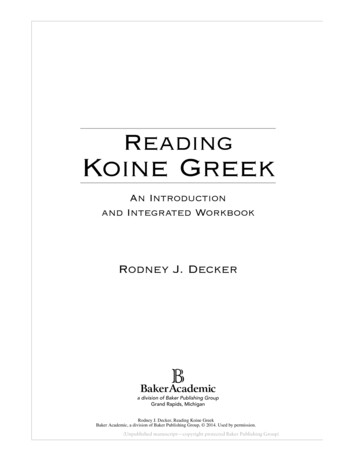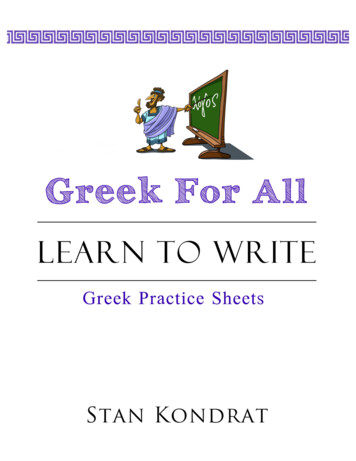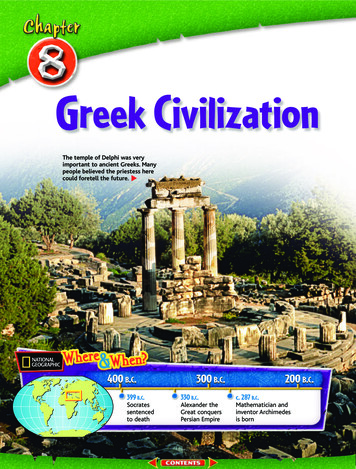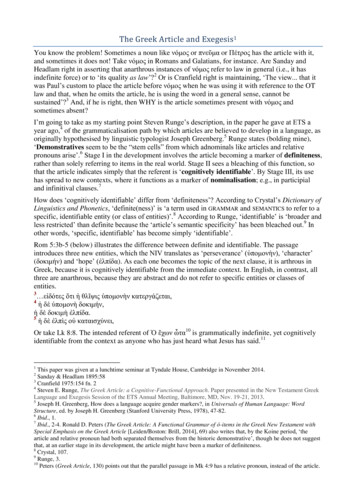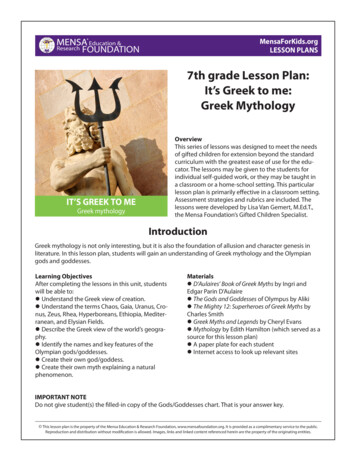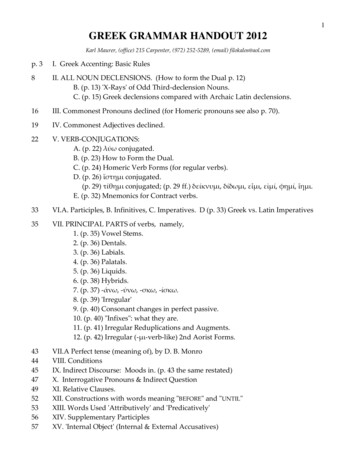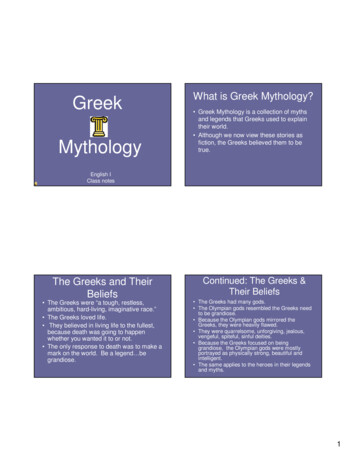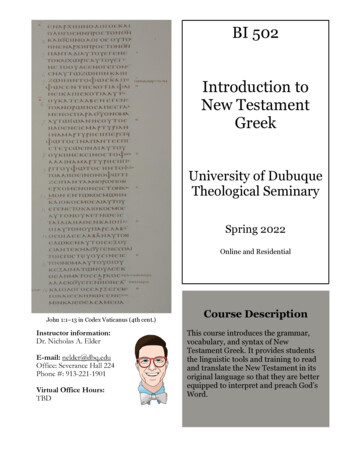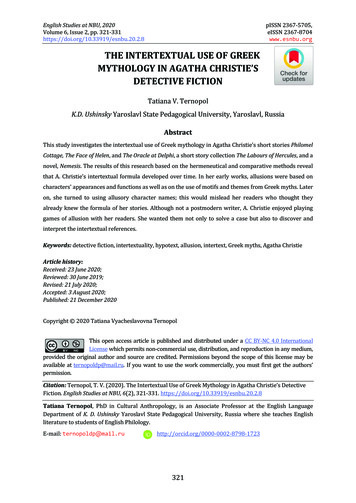
Transcription
English Studies at NBU, 2020Volume 6, Issue 2, pp. 321-331https://doi.org/10.33919/esnbu.20.2.8THE INTERTEXTUAL USE OF GREEKMYTHOLOGY IN AGATHA CHRISTIE’SDETECTIVE FICTIONpISSN 2367-5705,eISSN 2367-8704www.esnbu.orgTatiana V. TernopolK.D. Ushinsky Yaroslavl State Pedagogical University, Yaroslavl, RussiaAbstractThis study investigates the intertextual use of Greek mythology in Agatha Christie’s short stories PhilomelCottage, The Face of Helen, and The Oracle at Delphi, a short story collection The Labours of Hercules, and anovel, Nemesis. The results of this research based on the hermeneutical and comparative methods revealthat A. Christie’s intertextual formula developed over time. In her early works, allusions were based oncharacters' appearances and functions as well as on the use of motifs and themes from Greek myths. Lateron, she turned to using allusory character names; this would mislead her readers who thought theyalready knew the formula of her stories. Although not a postmodern writer, A. Christie enjoyed playinggames of allusion with her readers. She wanted them not only to solve a case but also to discover andinterpret the intertextual references.Keywords: detective fiction, intertextuality, hypotext, allusion, intertext, Greek myths, Agatha ChristieArticle history:Received: 23 June 2020;Reviewed: 30 June 2019;Revised: 21 July 2020;Accepted: 3 August 2020;Published: 21 December 2020Copyright 2020 Tatiana Vyacheslavovna TernopolThis open access article is published and distributed under a CC BY-NC 4.0 InternationalLicense which permits non-commercial use, distribution, and reproduction in any medium,provided the original author and source are credited. Permissions beyond the scope of this license may beavailable at ternopoldp@mail.ru. If you want to use the work commercially, you must first get the authors’permission.Citation: Ternopol, T. V. (2020). The Intertextual Use of Greek Mythology in Agatha Christie’s DetectiveFiction. English Studies at NBU, 6(2), 321-331. https://doi.org/10.33919/esnbu.20.2.8Tatiana Ternopol, PhD in Cultural Anthropology, is an Associate Professor at the English LanguageDepartment of K. D. Ushinsky Yaroslavl State Pedagogical University, Russia where she teaches Englishliterature to students of English Philology.E-mail: 1723321
Tatiana V. TernopolBackground and aimsAgatha Christie is the best-selling novelist of all time. There is a wealth ofscholarly and popular research on her life and works. Her detective novels and shortstories have long been considered as belonging to pop culture balanced on the edge ofliterature and sub-literature. Subsequently, many authors focus on her personal life andher mysterious disappearance between 3 and 14 December1926 (e.g. Morgan, 1985;McCall, 2001; Cade, 2011 etc.) rather than the merits of her literary work.Scholarly research of her fiction revolves around the following issues: A.Christie's role in the history of detective novel (Knight, 2004); composition and style ofher books (Lovitt, 1990; Alexander, 2009); screen adaptations (Aldridge, 2016); genderapproach (Makinen, 2006); translation of A. Christie's works (Hudácskó, 2016; Dash,1975); the use of poisons in her novels (Molin, 2010; Gerald, 2010).Intertext and intertextuality in Christie’s fiction have attracted less academicattention. For example, Makinen (2016) and Hamblen (2014) investigate the influenceon A. Christie of British and American writers respectively. Rowland (2010) analyzesthe use of Breton legends in her writing and concludes that all detective fiction isessentially mythical. Berger (2015) describes the creation of Hercule Poirot by AgathaChristie as probably the most important popular culture adaptation of the myth ofHercules. Margaret (2012) unveils the intertext of the Greek mythology in The Laboursof Hercules. Jackson (2015) examines some of the classical allusions Christie makes inher work, specifically in her Miss Marple novels, including Nemesis. Book reviews bybloggers such as Margaret and Jackson lack deep philological analysis of Christie’s textsand are based mainly on their personal attitude towards detective stories. Zavyalova(2014, 2017) looks at the sources of intertextuality in Russian and English detectivestories such as Greek and Roman mythology, the Bible etc.; however, in her analysis ofChristie’s works she focuses on allusions based on nursery rhymes and Shakespeare’stragedies.The aim of this paper based on hermeneutical and comparative methods is tocontribute to the study of the intertextual use of Greek mythology in Agatha Christie’sfiction and discover her formula for the use of ancient allusions. The very names of theworks we will look at in this paper bear allusions to Greek mythology, i.e. short stories322
INTERTEXTUAL USE OF GREEK MYTHOLOGY IN AGATHA CHRISTIE’S The Face of Helen (1930), The Oracle at Delphi (1934) and Philomel Cottage (1948), ashort story collection, The Labours of Hercules (1947) and a novel, Nemesis (1971).Greek mythology in Christie’s short storiesAccording to her Autobiography, Agatha Christie was home-schooled by herparents and showed a deep interest in reading from an early age (Christie, 1977). Shewas an avid reader of Greek mythology and ancient literature. However, it was not untilmid-1920s that Greek mythology found its way into her own books. The very title ofPhilomel Cottage, a short story published in 1924, has a loose allusion to the story ofPhilomela and Procne. Later on, Agatha Christie frequently used titles drawn fromliterature and folklore. The titles of her mythology-based stories usually feature namesof Greek heroes and gods in a search for analogies between these mythical charactersand common people depicted in her books.Of course, she was not unique in turning to Greek mythology for inspiration. InJames Joyce’s Ulysses (1924), an ordinary Jew from Dublin is compared to Odysseus.Many writers of first half of the twentieth century were in one way or anotherinfluenced by this book. Though A. Christie was not a modernist writer, she did usecertain modernistic literary techniques (e.g. stream of consciousness in And Then ThereWere None). Her books based on ancient allusions can be divided into two groups, i.e.earlier writings (short stories, Philomel Cottage, The Face of Helen, The Oracle at Delphiand a collection of short stories, Labours of Hercules, all written and published between1924-1947) and a mature novel, Nemesis (1971).The earlier works are less dramatic; the crimes are not serious (stealing,blackmail) or even prevented by a private detective. All of them have a happy ending. Ifsomebody has to die, it is a criminal who deserves this fate. Agatha Christie seems to bea little ironic in her attitude towards her characters that she compares to heroes ofGreek mythology. Her description of Hercule Poirot is a brilliant example of this irony,Here, then, was a modern Hercules – very distinct from that unpleasant sketch of anaked figure with bulging muscles, brandishing a club. Instead, a small compact figureattired in correct urban wear with a moustache (The Labours of Hercules)323
Tatiana V. TernopolThe comparison between ancient heroes and A. Christie's characters in herearlier stories can be seen in their appearance and functions. A beautiful girl at thetheatre reminds Mr. Satterthwaite of Helen of Troy,‘Beauty!’ said Mr Satterthwaite to himself. ‘There is such a thing. Not charm, norattraction, nor magnetism, nor any of the things we talk about so glibly – just sheerbeauty. The shape of a face, the line of an eyebrow, the curve of a jaw. He quoted softlyunder his breath: ‘The face that launched a thousand ships.’ And for the first time herealized the meaning of those words.’ (The Face of Helen)Miss Jillian West is described without any irony and her beauty (as Helen's) isher curse. The ability of common people to resemble Greek heroes is also observed byHercule Poirot; he describes Ted Williamson, a garage mechanic as ‘a simple young manwith the outward semblance of a Greek god. a Greek god – a young shepherd in Arcady’(Christie, 1947).In the other stories the characters' appearance usually has some peculiarfeatures that are associated with a certain mythological hero. It is especially clear in"The Labours of Hercules" where humans share some features with the chthonicmonsters slain or captured by Hercules. For example, a girl's hair was ‘like gold – it wentup each side like wings – and she had a gay kind of way of tripping along’ (Christie,1947). The girl was reminiscent of the Ceryneian Hind with its golden antlers and shehad even danced a part of a Hind in some ballet performances. A young naval officer is‘tall, magnificently proportioned, with a terrific chest and shoulders, and a tawny headof hair. There was a tremendous air of strength and virility about him.’ (Christie,1947). Hercule Poirot could not but compare him to ‘the young Bull – yes, one might saythe Bull dedicated to Poseidon’ (Christie, 1947) as the Cretan Bull had been.Sometimes characters are not so pleasant looking. For example, two women metby a young politician Harold Waring by Lake Stempka ‘had long, curved noses, likebirds, and their faces, which were curiously alike, were quite immobile. Over theirshoulders they wore loose cloaks that flapped in the wind like the wings of two bigbirds’ (Christie, 1947). The lake was not Lake Stymphalion, but its name was assignificant as the women's appearance so the character considered them an ill omen.324
INTERTEXTUAL USE OF GREEK MYTHOLOGY IN AGATHA CHRISTIE’S Humans are not the only one to be compared to the chthonic monsters.Sometimes, Christie is even more ironic and the awful beasts of Greek mythologybecome nice pets. Dogs represent both the Nemean Lion and Cerberus: a tiny Pekineseand a huge black hound. The last one was so loyal and obedient that its master used it tocarry sealed packets of cocaine.Thus, it is obvious that Christie's characters not only resemble their ancientprototypes outwardly but also share their characters and perform functions associatedwith them. Her Cerberus guarded the door of a fashionable nightclub Hell situated in abasement. Every visitor had to give it a treat to be able to enter. In The Apples ofHesperides, Hercule Poirot used a man named Atlas to steal a gold goblet decorated withemerald apples. Atlas helped him to break into the convent by offering his back to climbthe wall. Here A. Christie combines two main functions of mythological Atlas: he holdsthe celestial heavens on his back and steals the golden apples from the garden ofHesperides for Hercules.In Trojan myths, Helen of Troy is a synonym of a woman whose charms areirresistible and cause trouble to men. In The Face of Helen, the main character has a lotof “unpleasantness”:Between them, Mr. Satterthwaite became enlightened as to various happenings whichwere vaguely classed by Burns under the heading of unpleasantness. "A young man whohad shot himself, the extraordinary conduct of a Bank Manager (who was a marriedman!) a violent stranger (who must have been balmy!) the wild behaviour of an elderlyartist. A trail of violence and tragedy that Gillian West had left in her wake, recited in thecommonplace tones of Charles Burns. (Christie, 2010).However, Christie's approach to allusions connected with mythological functionswas not the same in all her works. She frequently used mythological allusions to deceiveher readers trying to solve the case. Some of her characters associated with the chthonicmonsters in The Labours of Hercules because of their appearance are harmlesscreatures. For example, the two ugly-looking sisters in The Stymphalion Birds neverthought of anything connected with crimes, but the main character (and readers aswell) accuse them of blackmail. Sometimes a character is referred to mythologicalcharacters on purpose to make the other characters believe he or she can perform325
Tatiana V. Ternopolcertain functions. In The Oracle at Delphi, Mrs. Peters whose son had been kidnappedturned for help to a person who had advertised himself as a new oracle. He said hecould give people advice to solve their problems. In fact, the oracle was the criminalwho had organized the kidnapping.Allusions to appearance and functions of mythological characters are not theonly one used by the author. In several stories, she employed the whole plot of a certainmyth. To trace the beautiful lady's maid Nita, Hercule Poirot had to travel across Europesimilar to Hercules chasing the Ceryneian Hind all over Greece. The use of amythological plot can also be found in the Cretan Bull, The Apples of Hesperides and TheCapture of Cerberus. Employing the whole plot is a peculiar feature of the stories in TheLabours of Hercules. However, it is clear that Agatha Christie started by using not theplots but recognizable motifs. A fight between two suitors in The Face of Helen instantlyreminds readers of Menelaus and Paris. Later, the girl in the story broke up with herboyfriend and was engaged to a new one associated with Paris and Helen's elopement.Nevertheless, it did not lead to a war between the young men (Christie did not use theplot of the myth).In Philomel Cottage, the writer adapts a less popular myth about two sisters,Philomel and Procne. Procne's husband Tereus raped and mutilated Philomel and kepther imprisoned in a hut in the wood. She made a beautiful carpet depicting her storyand sent it to her sister. In revenge, Procne killed Tereus' son Itis (Takho-Godi, 1982, p.337). Christie employs several motifs from the myth, i.e. an abusive husband (AlixMartin's husband killed several women whom he had married for money);imprisonment and abuse of a woman (the husband hid the main character in a distantcottage and was preparing to get rid of her); a smart plan worked out by the victim (Alixmanaged to warn her ex-boyfriend who rescued her); a revenge (the criminal died offear because he thought Alix had poisoned him).As for The Oracle at Delphi, the only motif from Greek mythology Christie usedwas connected with the main function of the ancient oracle: he gave useful advice in anydifficult situation.If we consider the chronological order of the short stories, it is obvious thatChristie started by using certain motifs from Greek mythology and ended up using the326
INTERTEXTUAL USE OF GREEK MYTHOLOGY IN AGATHA CHRISTIE’S plots in The Labours of Hercules. In the short-story collection, she also applied ametaphoric approach to plots and characters. The Lerneaen Hydra became a metaphorof gossips few people can fight with; the Augean Stables in a need of cleaningrepresented a political scandal. Hercule Poirot came up with a clever scheme first toruin and then to clear the reputation of the Prime Minister's wife just as Herculesproceeded with the Augean Stables.Christie's formula of using Greek myths in her earlier works is represented bythe titles and the allusions to the appearance of the characters, their functions, plots andmotifs of myths. Sometimes she treats Greek myths as metaphoric stories of people'sflaws and sins. Nevertheless, she does not seem to take her stories seriously. Herintention is to make her readers smile comparing the situations in the stories to themyths they studied in school.Greek mythology in NemesisIn her later works, Christie turned to folklore and literary allusions and did notreturn to Greek mythology until 1970s in her last novel about Miss Marple. The book isentitled Nemesis in line with the author’s intention to clearly point to the hypotext sheuses. However, it is not only twenty years which separate the novel from her earliershort stories. The formula she uses is new.First, there are no well-known stories about Nemesis in the Greek mythology.She was honoured as a goddess of retribution and sometimes named the mother ofHelen of Troy, but there were no myths directly associated with her (Takho-Godi, 1982,p. 209). There were not any notable features in her appearance except for the wings,according to Mesomedes (Mesomedes, 2011). She was kin to Clotho, Lachesis andAtropos, the Moirai who span the thread of life for every mortal and it was Atropos whocut it. Greeks considered them to be sisters and usually portrayed them as white-robedold women (Losev, 1982, p. 169).In Nemesis, allusions to the mythological creatures are clear, because MissMarple was named Nemesis by a late millionaire Jason Rafiel who wanted her to solvethe case of an old murder. The main suspects are three elderly sisters with remarkablenames: Clotilde (the eldest), Lavinia and Anthea (the youngest). The names are allusionsto the Moirai, as well as the fact that they are sisters and live together. Clotilde327
Tatiana V. Ternopolreminded Miss Marple of Clytemnestra while Anthea brings to mind allusions ofOphelia:She could be cast successfully as a mature Ophelia, Miss Marple thought. Clotilde, MissMarple thought, was certainly no Ophelia, but she would have made a magnificentClytemnestra she could have stabbed a husband in his bath with exultation. (Christie,1971)Christie tries out a new technique of creating allusions to mythological heroes bygiving her characters speaking names, although not as obvious as Hercule or Atlas inThe Labours of Hercules. At the same time, the character's appearance becomes lesssignificant; Miss Marple and the Bradbury-Scotts are described as elderly womenwithout any peculiarities of their prototypes.As for the functions, Miss Marple lived up to the role of Nemesis. She strictlyfollowed Mr. Rafiel's plan to solve the case and the criminal who had killed three womenand tried to kill Miss Marple committed suicide. The innocent man was acquitted.The three Bradbury-Scott sisters did not perform the Moirai's functions for theywere not fond of spinning or doing any needlework (it was Miss Marple who enjoyedknitting), but one of them was definitely guilty of several murders, and it was MissMarple's job to expose her.In the novel, Christie did not use the plot of any Greek myth; in fact, the tragic storyof Verity Hunt and Michael Rafiel was based on Romeo and Juliet with Miss Temple as theNurse and Archdeacon Brabazon as Friar Lorenzo. The images of ancient goddesses andheroes were used to mislead the readers into searching for allusions to the Greekmythology.After learning Verity's story (Chapter 10), Miss Marple grew suspicious that atleast one of the sisters should know something about the murders and by Chapter 15 shewas sure that either Clotilde or Anthea was responsible for the crimes. Lavinia was awaywith her husband when Verity was killed. At this point, the evidence was against Antheawho was mentally unstable and represented Antropos, the Moira who cut the thread oflife and chose the manner of a person's death. The allusion suggested that Anthea wasguilty, but in fact it was Clotilde who constantly reminded Miss Marple of Clytemnestra, a328
INTERTEXTUAL USE OF GREEK MYTHOLOGY IN AGATHA CHRISTIE’S cruel murderer of her husband. Readers knowledgeable of the Greek mythology will alsoremember that the Moira responsible for cutting the thread was the eldest of the sisters.Thus, the technique of using the hypotext of Greek myths in Nemesis is differentfrom the earlier approach. The plot is tragic because of three murders and a longimprisonment of an innocent person. The mood of the text is gloomy as most of thecharacters are elderly and lonely people. There is no place for irony so common in theearlier short stories. Christie continued using allusions in titles with reference to certainfunctions of the characters' prototypes and motifs but refrains from employingmythological plots. A new technique was to use speaking names, i.e. allusions to hercharacters' mythological prototypes, thus misleading the readers who tried to solve thecase searching for allusions to the Greek mythology.ConclusionThe results of this research based on the hermeneutical and comparativemethods reveal that A. Christie’s intertextual formula developed over time. In her earlyworks, allusions were based on characters' appearances and functions as well as the useof motifs and themes from the Greek myths. Later on, she turned to using allusorycharacter names. This would mislead her readers who thought they already knew theformula of her stories. Although not a postmodern writer, A. Christie enjoyed playinggames of allusion with her readers. She wanted them not only to solve a case but also todiscover and interpret the intertextual references.ReferencesAldridge, M. (2016). gatha Christie on Screen. Palgrave 5Alexander, M. (2009). Rhetorical structure and reader manipulation in Agatha Christie’sMurder on the Orient Express. Miscelánea: A Journal of English and AmericanPhilology, 39, 13-27. http://eprints.gla.ac.uk/32230/1/id32230.pdfBerger A.A. (2013). Hercules (aka Herakles) and Hercule Poirot. In A. A. Berger. Media,Myth, and Society (pp 90-98). Palgrave.https://doi.org/10.1057/9781137301673 6Cade, J. (2011). Agatha Christie and the Eleven Missing Days. Revised edition. Peter OwenPublishers.329
Tatiana V. TernopolChristie A. (1934). The Oracle at Delphi. In Christie A. Parker Pyne Investigates. CollinsMystery.https://royallib.com/read/Christie Agatha/Parker Pyne Investigates.html#0Christie A. (1947). The Labours of Hercules. Dodd, Mead & Co.http://booksonline.com.ua/view.php?book 157951Christie A. (1971). Nemesis. Collins Crime Club.http://booksonline.com.ua/view.php?book 98843Christie A. (1977). An Autobiography. Collins.Christie A. (2010) The Face of Helen. In Christie A. The Mysterious Mr. Quin.HarperCollins. terious-mr-quin.html#textChristie A. (2011). Philomel Cottage. London: hristie-short-story-841503.htmlDash, F. L. (1975). Miss Marple Goes to Spain. Modern Languages, 56, 177-180.Gerald, M. (2010). The Poisonous Pen of Agatha Christie. University of Texas Press.Jackson, K. (2015). Classical Allusions and Miss en, A. (2014). The Inheritance of the Meek: Two Novels by Agatha Christie andHenry James. Discourse, XII, 409-413.Hudácskó, B. (2016) And Then There Were Many: Agatha Christie in HungarianTranslation. In Bernthal J.C (Ed.), The Ageless Agatha Christie: Essays on theMysteries and the Legacy. McFarland & Company.Knight, S. (2004). Crime Fiction 1800-2000: Detection, Death, Diversity. PalgraveMacmillan.Losev. A. (1982). Moiry. [The Moirai]. In Tokarev S.A. (Ed.), Mify narov mira. [Myths ofthe World]. (p. 169). Sovetskaya Yenciclopediya.Lovitt. C. (1990). Controlling Discourse in Detective Fiction: or, Caring Very Much WhoKilled Roger Ackroyd. In Walker R. & Frazer J. (Eds.), The Cunning Craft: OriginalEssays on Detective Fiction and Contemporary Literary Theory. (pp. 68-85).Western Illinois University.Makinen, M. (2006). Agatha Christie: Investigating Femininity (Crime Files). PalgraveMacmillan. https://doi.org/10.1057/9780230598270330
INTERTEXTUAL USE OF GREEK MYTHOLOGY IN AGATHA CHRISTIE’S Makinen, M. (2016). Agatha Christie in Dialogue with To the Lighthouse: The ModernistArtist. In Bernthal J.C (Ed.), The Ageless Agatha Christie: Essays on the Mysteriesand the Legacy. McFarland & Company.Margaret (2012). The Labours of Hercules by Agatha Christie: a Book Review.BooksPlease. A book lover writes about this, that and the ll, H. (2001). The Life of Max Mallowan: Archaeology and Agatha Christie. BritishMuseum Press.Mesomedes (2011) Hymn to Nemesis (Trans. Foreman 5/mesomedes-hymn-tonemesis-from-greek.htmlMolin Ju. A. (2010). Tvorchestvo Agaty Kristi – Medicinskie aspekty (k 120-letiju sodnya rozhdeniya). [Works of Agatha Christie – Medical Aspects (dedicated to her120 anniversary)]. Medicinskaya ekspertiza i pravo, 6, 49-50.Morgan, J. (1985). Agatha Christie: A Biography. Fontana/Collins.Rowland, S. (2010). The Wasteland and the Grail Knight: Myth and Cultural Criticism inDetective Fiction. Clues: A Journal of Detection, 28(2) (Fall), i, A. (1982). Procna. [Procne]. In Tokarev S.A. (Ed.), Mify narov mira. [Myths ofthe World]. (p. 337). Sovetskaya Yenciclopediya.Takho-Godi, A. (1982). Nemesida. [Nemesis]. In Tokarev S.A. (Ed.), Mify narov mira.[Myths of the World]. (p. 209). Sovetskaya Yenciclopediya.Zavyalova, G. (2014). Osobennosti funkcionirovanija precedentnyh fenomenov vdetektivnom diskurse (na materiale anglijskogo i russkogo jazykov). Dissertacijana soiskanie uchenoj stepeni kandidata filologicheskih nauk. Kemerovo.[Peculiarities of the functioning of precedent texts in detective fiction (withexamples from Russian and English fiction]. [Unpublished doctoral dissertation].Kemerovo.Zavyalova, G. (2017). Istochniki precedentnosti v detektivnom diskurse. VestnikKemerovskogo gosudarstvennogo universiteta, 2017, 2, 195-199 [Sources ofprecedent texts in detective fiction. Bulletin of Kemerovo State 7-2-195-199Reviewers:1. Anonymous2. AnonymousHandling Editor:Boris Naimushin, PhD,New Bulgarian University331
Agatha Christie is the best-selling novelist of all time. There is a wealth of scholarly and popular research on her life and works. Her detective novels and short . "The Labours of Hercules" where humans share some features with the chthonic monsters slain or captured by Hercules. For example, a girl's hair was like gold ' - it went


